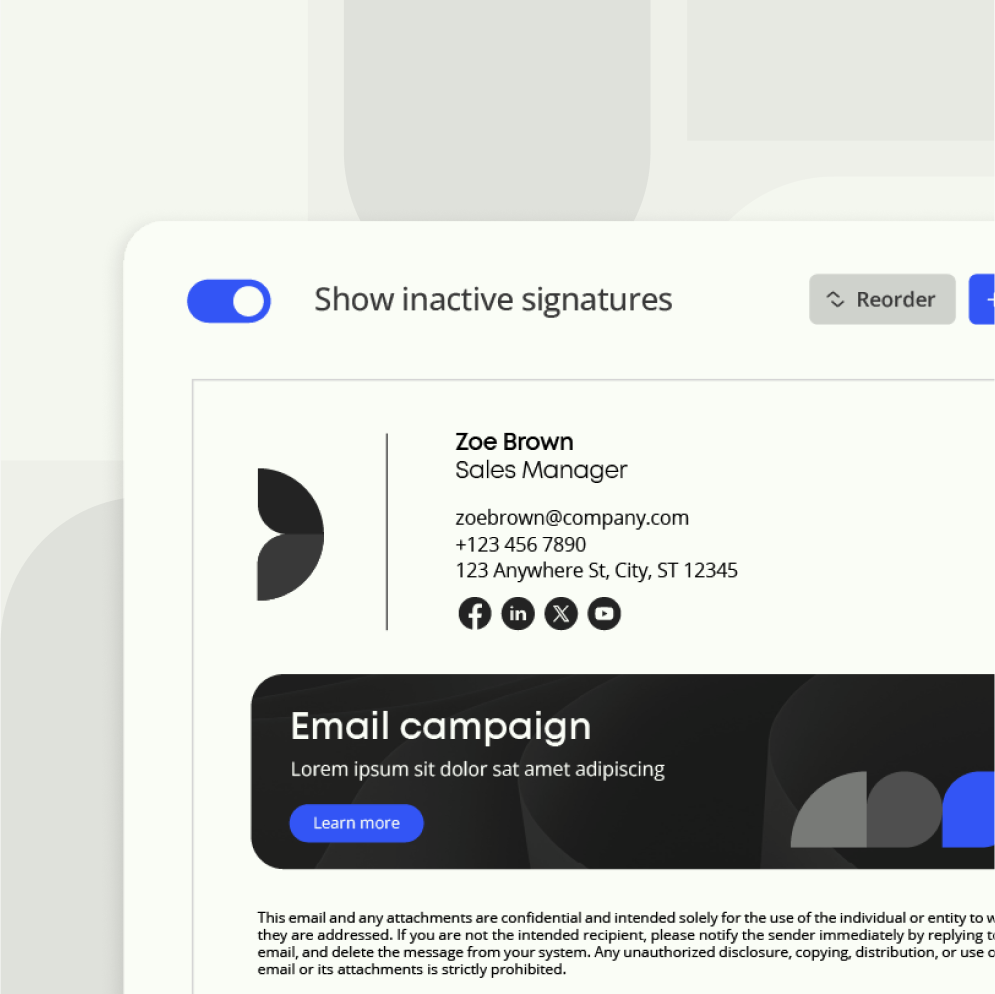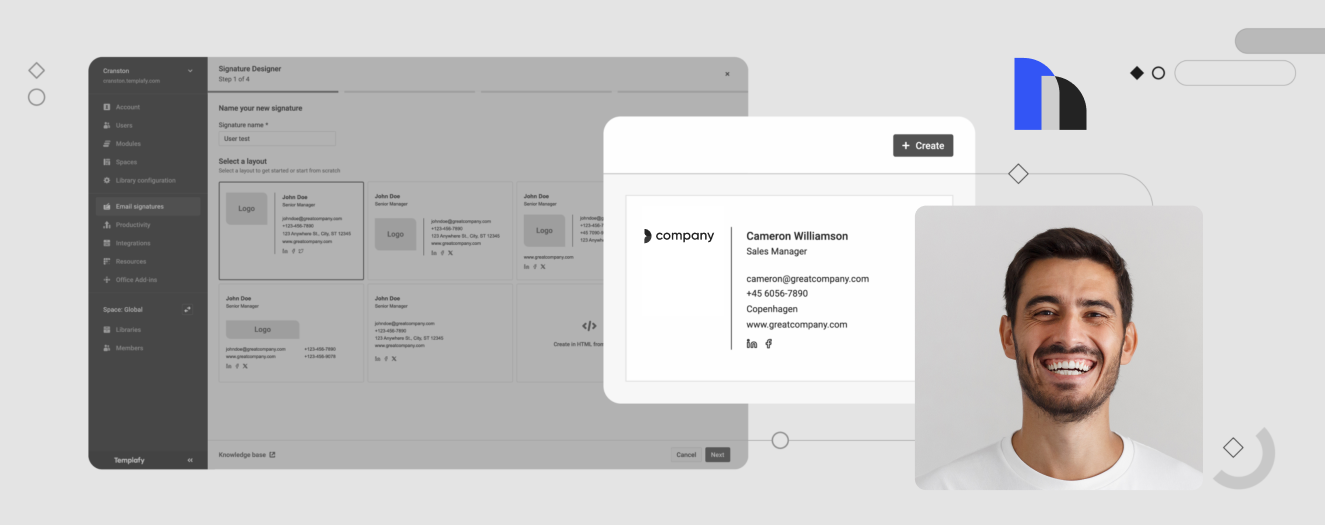Maximize your email marketing ROI with these proven strategies

Everything you need to know to make your emails work for you, not against you
Despite countless new marketing channels emerging each year, businesses continue to find their highest returns in an unexpected place: the inbox. According to Litmus’s 2023 State of Email report, email marketing generates an average ROI of $36 for every dollar spent, making it one of the most cost-effective marketing channels available.
But your email marketing potential extends far beyond promotional campaigns. Every single business email represents a marketing opportunity. Research from Radicati Group shows that the average business user sends and receives 126 emails per day. For a company of 1,000 employees, that’s over 120,000 daily touchpoints with potential marketing impact.
Let’s explore how businesses are maximizing their email marketing potential and what strategies are proving most effective in 2025. From automation to AI-powered solutions, the tools available today make it easier than ever to turn every email into a valuable marketing touchpoint.
The current state of email marketing
But before we get to exactly how Templafy can assist with email marketing, let’s look at a few stats on Small businesses know something big companies sometimes forget: email still works better than most marketing channels. Campaign Monitor found that 64% of small businesses rely on email as their main way to reach customers. But it’s not just about sending more emails—it’s about sending better ones.
When you can speak directly to what your customers care about, they listen. Research from HubSpot shows that personalized emails get 29% higher open rates and 41% higher click rates than generic messages. But as it stands now, only about a third of businesses actually personalize their emails. That’s a big opportunity most companies are missing.
Benefits of email marketing
There’s a lot of hype around different marketing channels, but email marketing’s benefits are backed by real numbers. Here’s what makes it so powerful.
Data-driven decision making
Email marketing provides unprecedented insight into your customer interactions. Beyond basic metrics, you can track exactly how customers progress through their journey with your brand. This includes understanding which content resonates most, identifying optimal sending times for different audience segments, and measuring the exact return on your marketing investment.
According to Campaign Monitor, businesses can track:
- Who opens their emails (average open rate: 21.5%)
- Which links people click (average click-through rate: 2.3%)
- How many emails lead to sales
- When people unsubscribe
This data helps you make each email better than the last.
Direct access to your audience
Unlike social media where algorithms control content visibility, email provides direct inbox access. This direct line means more control over when and how you reach customers, leading to better engagement rates.
Email also allows for sophisticated personalization beyond just adding names. You can tailor content based on past purchase behavior, website interactions, geographic location, customer lifecycle stage and more.
Additional content
More tools for creating great email signatures
Here’s what else you need to know about centralizing email signature management and distribution.


Common email marketing challenges
Making the most of email marketing isn’t always straightforward, but addressing these obstacles head-on can help unlock email’s full potential.
Getting past the spam folder
It’s not enough just to send emails—they need to reach the inbox. Nearly 1 in 6 emails never make it to the inbox, usually due to poor sender reputation, spam-triggering content, and outdated email lists.
Dealing with audience fatigue
Everyone’s inbox is crowded. The average office worker receives 121 emails per day, and that number keeps growing. When people feel overwhelmed, they’re more likely to unsubscribe or simply stop engaging. Research from Constant Contact shows that 69% of users unsubscribe because they receive too many emails.
Creating content that people actually want
Coming up with fresh, relevant content for your emails is tough. Sometimes, it’s about shifting the focus from what you want to say to what your audience wants to read. 17% of people unsubscribe from emails if the content feels overpromotional or spammy.
email marketing
Effective email strategies that work
- Build your email list the right way
- Smart segmentation makes a difference
- Craft subject lines that get noticed
- Compliance and data protection
- Make mobile your priority
- Testing: Your path to better results
- The power of smart automation
- Make your email signatures count
Email tips, delivered
Make every email count with tips on managing on-brand, compliant signatures—plus ways to turn emails into marketing opportunities.
Let’s explore proven strategies that consistently deliver results, starting with the foundation of any successful email marketing program: your subscriber list.
Build your email list the right way
Buying email lists might seem like a shortcut, but it usually backfires. Research consistently shows that organic email lists perform far better than purchased ones, with much higher open rates and engagement. Instead of taking shortcuts:
- Create valuable content people want to sign up for
- Use sign-up forms on your website
- Offer something useful in exchange for email addresses, like guides or discounts
Smart segmentation makes a difference
Not everyone in your audience wants the same thing. Breaking your email list into smaller groups helps you send more relevant messages. According to Campaign Monitor, marketers who use segmentation see significantly higher open rates and click rates than those sending the same message to everyone. Think about grouping your audience by:
- How they interact with your content
- What they’ve bought before
- Where they are in their customer journey
Craft subject lines that get noticed
Your subject line is like the headline of a newspaper—if it doesn’t grab attention, the rest doesn’t matter. While there’s no magic formula, research shows that personalized subject lines get opened more often. Some proven approaches:
- Keep it short and clear
- Create a sense of urgency (without being pushy)
- Ask interesting questions
- Test different approaches to see what works for your audience
Compliance and data protection
Email marketing regulations can seem daunting, but they’re actually an opportunity to build trust with your audience. GDPR and CAN-SPAM Act compliance helps you avoid penalties, but it also demonstrates respect for your subscribers’ privacy. Maintaining detailed records of consent, providing clear unsubscribe options, and being transparent about data usage all contribute to a stronger relationship with your audience.
Keep your lists clean by regularly removing inactive subscribers and bounced addresses. This not only helps with compliance but also improves your sender reputation and delivery rates. Remember to include your physical business address in marketing emails and make it easy for recipients to understand how their data is being used.
Regular audit of your email practices helps ensure ongoing compliance:
- Review consent mechanisms quarterly
- Update privacy policies as regulations change
- Train team members on compliance requirements
- Document all email marketing processes
- Maintain detailed subscriber records
Make mobile your priority
Over 40% of email opens happen on mobile devices. Mobile optimization is about responsive design, but it’s also about understanding how people actually read emails on their phones. Consider someone checking their email during their morning commute or between meetings. They’re likely scanning quickly, looking for relevant information. This means your content needs to be immediately engaging and easy to digest.
Structure your mobile emails with:
- Clear, compelling headlines that grab attention
- Short paragraphs that are easy to scan
- Strategic use of white space
- Images that enhance rather than overwhelm
- Clear calls-to-action that stand out
Remember that mobile users often save longer emails for later reading on desktop devices. Make sure your design works seamlessly across all platforms, maintaining your brand’s visual identity while adapting to different screen sizes.
Testing: Your path to better results
The best way to improve your email marketing is to try new things and learn from the results. Stop guessing and start looking closely at what works for your specific audience.
HubSpot’s research shows that companies that regularly test their emails see 37% better results. The trick is to keep it simple at first. Start by testing one thing at a time, like trying different subject lines with small groups or sending emails at different times. When you find something that works, build on that success.
The power of smart automation
Email automation no longer means cold, robotic messages. Today’s automation tools help you send warm, timely emails that feel personal. Think about the last time you got a friendly welcome email right after signing up for a service, or a helpful reminder about items in your shopping cart. These automated touches can make a big difference—personalized automated emails get opened up to 4 times more often than generic bulk messages.
The key is making sure your automated emails feel personal and work together smoothly. Tools like Templafy can help by managing email signatures and brand consistency across all your communications, while your marketing automation handles the sending schedule. This combination of automated timing and consistent branding helps build trust with your audience.
Make your email signatures count
Every email your team sends is a chance to make an impression. Professional email signatures might seem like a small detail, but they add up when you consider how many emails your company sends each day. Tools like Templafy’s email signature management help keep everyone’s signatures consistent and professional while turning them into valuable marketing opportunities.
Notable email marketing success stories
The best way to understand what makes email marketing work is to look at real examples. Here’s how some of the world’s most successful companies are getting it right.
B2C success stories
Dollar Shave Club set the standard for engaging transactional emails. Their transactional emails have open rates of around 70%, compared to the average email open rate of less than 18%. Their success comes from combining humor with clear value propositions that solve real customer problems.
Airbnb turned their referral program into a powerful growth engine. By launching “Referrals 2.0,” which gave both sender and recipient $25 in travel credit, they increased their booking and signup rates by 300% compared to their previous referral program. Their approach shows how effective referral programs can be when backed by strategic timing and proper incentives.
B2B success stories
Mailigen improved their email open rates from 20% to 29% by implementing behavioral segmentation. The company had previously struggled with open rates that hovered between 10-20%, which was standard for their industry. They achieved this improvement by using behavioral segmentation, which most email marketers weren’t utilizing at the time.
SmartBear Software, a B2B cloud mobile software company, transformed their marketing through automation implementation, which led to remarkable results: their lead volume grew by 200%, with 80% of global leads generated through automated trial downloads, and 85% of their revenue coming from these trial download leads. The company started with basic email campaigns and quickly expanded to implement lead nurturing across different product groups, even integrating their webinar platform into the automation solution.
Turning every business email into a marketing opportunity
These success stories show what’s possible with dedicated marketing campaigns, but what about the thousands of everyday emails your team sends? That’s where the real untapped potential lies.
According to Adobe, professionals spend an average of 3.1 hours each day on work email. That’s why having the right tools to manage email communications efficiently is crucial. Every email from every employee, whether it’s a quick reply to a customer or a meeting confirmation, can reinforce your brand and drive engagement.
Think about launching a new service across different regions. Your sales teams need to reach out to their contacts personally, but you want to maintain consistent branding while adapting messages for each region’s specific needs—different pricing, promotions, and legal requirements. Without the right tools, managing all these variations becomes a logistical challenge.
This is where smart email signature management makes a difference. Templafy’s platform integrates directly with Office 365 and Outlook, making it simple to maintain brand consistency while allowing for necessary customization. When employees open their email, they automatically get access to the right promotional text, compliance information, and email signatures for their specific region or role.
Making email signatures work harder
Email signatures might seem like a small detail, but they can make a big difference in the long run. When done well, email signature banners can help direct traffic to your website, promote new content, advertise special offers and events, and help you stand out from the crowd. This means every business email can become an opportunity for brand visibility and engagement.
With centralized management, you can transform these everyday touchpoints into valuable marketing assets. Companies using managed email signatures report increases in campaign engagement when including targeted banners in their signatures. This approach works because these messages often appear in trusted, one-to-one communications.
AI-powered email creation and management
Writing compelling emails at scale can be challenging, but AI is changing the game. Templafy’s GenAI solution brings trusted, enterprise-grade AI capabilities directly into your email workflow. Instead of switching between different apps or risking unauthorized AI tools, your team can access company-approved AI assistance right within Outlook.
The key difference is control. Unlike generic AI tools, Templafy’s solution uses custom prompts and your organization’s tone of voice guidelines to ensure consistency across all communications. This means your team can craft engaging emails faster while maintaining your brand voice and compliance standards.
Looking ahead: The future of email marketing
Email continues to evolve, but one thing remains clear: it’s still the most effective way to reach customers with relevant, timely information. The key to success isn’t just sending more emails—it’s sending smarter emails that speak to your audience’s needs.
The most successful companies aren’t just focusing on marketing campaigns anymore. They’re looking at every email as an opportunity to strengthen their brand and connect with their audience. Whether it’s a marketing newsletter or a quick reply from customer service, each message matters.
Ready to make your business emails work harder? Visit Templafy’s email signature management solution to discover how centralized signature management can help strengthen your brand and improve your marketing reach while saving valuable time.


